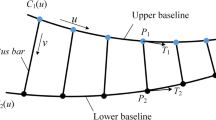Abstract
Side milling is a process that enables machining time and thus costs, to be reduced. This type of machining is particularly well suited to ruled surfaces and all surfaces where one of the principal curvatures is very small compared to the tool radius and changes little over the entire surface. These surfaces must be treated with great care, as they are often on parts with high added value such as turbine blades, aircraft wings or helicoidal parts as used in fluid dynamics.
We then need to calculate and minimise interference that may arise if the ruled surface cannot be developed. Whereas machining is usually carried out by setting the tool according to a rule, we suggest a new setting of the tool allowing interference to be reduced considerably. The computation algorithms for this setting were developed so as to be used in real-time by CAD/CAM software.
A comparative study of errors made with each type of setting is also presented. This shows a considerable reduction in errors when the setting we suggest is implemented.
Similar content being viewed by others
References
K. Marciniak, “Geometric modelling for numerically controlled machining”, Oxford University Press, 1991.
B. K. Choi, J. W. Park and C. S. Jun, “Cutter-location data optimization in 5-axis surface machining”, Computer-Aided Design,25(6), pp. 377–386, 1993.
T. C. Chang and Y. S. Lee, “Machined surface error analysis for 5-axis machining”, International Journal of Production Research,34(1), pp. 111–135, 1996.
S. X. Li and R. B. Jerard, “5-axis machining of sculptured surfaces with a flat-end cutter”, Computer-Aided Design,26(3), pp. 165–178, 1994.
W. Rubio, P. Lagarrigue, G. Dessein and F. Pastor, “Calculation of tool paths for a torus mill on free-form surfaces five-axis machines with detection and elimination of interference”, The International Journal of Advanced Manufacturing Technology, 14, pp. 13–20, 1998.
W. Rubio, “Génération de trajectoires du centre de l'outil pour l'usinage de surfaces complexes sur machines à trois et cinq axes”, (Generation of cutter contact trajectories for machining of complex surfaces for three- and five-axis machines), thesis presented at University of Toulouse III, France, 1993.
X.-W. Liu, “Five-axis NC cylindrical milling of sculptured surfaces”, Computer-Aided Design, 27(12), pp. 887–894, 1995.
M. D. Carmo, “Differential geometry of curves and surfaces”, Prentice-Hall, 1976.
D. Qiulin and B. J. Davies, “Surface engineering geometry for computer aided design and manufacture”, Ellis Horwood, 1987.
I. D. Faux and M. J. Pratt, “Computational geometry for design and manufacture”, Ellis Horwood, 1985.
G. Elber and F. Russ, “5 Axis free-form surface milling using piecewise ruled surface approximation”, ASME Journal of Engineering for Industry, 119(3), pp. 383–389, 1997.
Author information
Authors and Affiliations
Corresponding author
Rights and permissions
About this article
Cite this article
Redonnet, J.M., Rubio, W. & Dessein, G. Side milling of ruled surfaces: Optimum positioning of the milling cutter and calculation of interference. Int J Adv Manuf Technol 14, 459–465 (1998). https://doi.org/10.1007/BF01351391
Issue Date:
DOI: https://doi.org/10.1007/BF01351391




